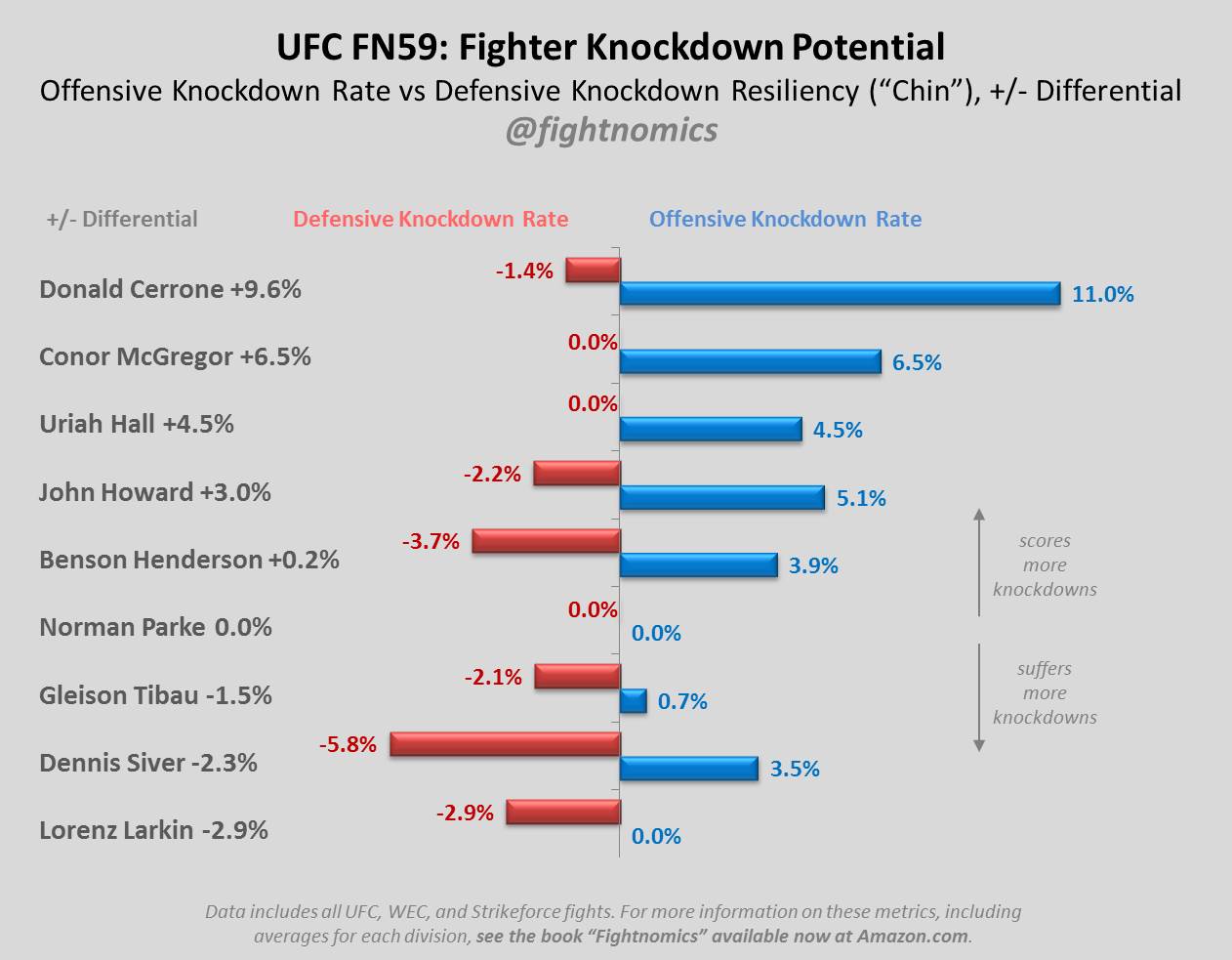By @fightnomics If boxing is a game of hit and don’t be hit, then MMA striking could be boiled down to scoring knockdowns, while not getting knocked down yourself. When a knockdown occurs, the one scoring it will go on to win the vast majority of the time. That’s not to say that you can’t get dropped and still come back to win, something Dan Henderson exemplified in his fight with Shogun Rua, it’s just not likely. And each fighter has their own capabilities, tendencies, and history when it comes to the MMA standup game. Some strikers are precision or volume strikers, some guys swing for the fences or jab their way to set up other things. Some guys mix in a lot of kicks and inherently boost the power and danger of their strikes, while others rely entirely on their hands. All of these factors come into play for a fighter’s personal Knockdown Rate metric. The average is in the 3% range, meaning when any single power head strike lands on target, there’s a 3% chance a knockdown will occur. Therefore, defensively the metric is the same. When getting hit with a hard shot to the head, on average, there’s a 3% chance you’ll fall down. Size matters a lot to this metric, and apparently so does cage size in that a larger cage allows more room to retreat and recover from a damaging setup blow. So all things being equal, most fighters will score and experience knockdowns at a similar rate for their weight class – except they obviously don’t. First, better fighters stick around much longer in the UFC, so the fighters we see on any card will be above average (“survivorship bias”). And within each division is a wide variety of fighters presenting different striking threats, as well as varying weaknesses. One way to examine a standup striking matchup is to see the knockdown profiles of each fighter, both offensive and defensive. The two competitors could be equally average in each respect, or you might find someone who excels at scoring knockdowns facing someone who is bad at avoiding them. Such is the case in the main event this weekend in Boston. When Conor McGregor faces Dennis Siver, the second most dangerous striker on the card will be facing the most vulnerable chin on the card. And that’s not all. Let’s take a look at how the fighters with sufficient sample size stack up in terms of the offensive versus defensive knockdown metrics. The arithmetic difference between the two values is listed next to each fighters name and they are ranked, with a more positive rating meaning their offensive and defensive are both good, and more negative ratings reflecting the opposite.
For more on Knockdown Rates, “Chin” resiliency and other MMA metrics, get the book “Fightnomics” at Amazon.
The Big Picture Given that the fighters populating a UFC main card have been largely successful throughout their MMA careers, we should expect to see better positive metrics than negative ones. And that’s what we see here. These fighters represent la crème de la crème of MMA, as they compete in the UFC and have also lasted long enough to warrant high card placement (in most cases). In the graph we see a lot more blue than red, meaning they have offensive ratings that are quantitatively more positive than their defensive ratings are negative. Hence, five fighters have a positive differential (the plus/minus rating), only three are negative, and one is neutral. We also see several fighter’s with more dangerous than average striking. Atop them all is Cowboy Cerrone, with a ridiculous 11% Knockdown Rate, meaning when he lands a power head strike on an opponent there’s a one-in-nine chance he’ll drop them right then and there. He’s recorded 13 knockdowns in his WEC/UFC career, and shows no signs of slowing his aggressive fighting style. Hell, he took this fight on two-week’s notice, that’s all you need to know about the guy. On the flipside, no one competing this weekend has been dropped more often than Dennis Siver (6 times), and he has the worst defensive knockdown metric on the card. That doesn’t bode well considering McGregor comes in safely as the second most dangerous striker on the card, ahead of larger fighters and even the TUF highlight reel star Uriah Hall. The Fine Print In terms of pairings, the main event is certainly an extreme case of a dangerous striker facing a vulnerable one. But the co-main event also reveals a similar pattern, just not as extreme. Cerrone’s striking game is nasty, and now that Henderson has suffered four knockdowns in his WEC/UFC career (3nd most on this weekend’s card), with his knockdown rating is on the decline and now just barely above neutral. In their first fight against one another, Cerrone got the better of Henderson in standup striking, so expect Henderson not to want to stand and trade but instead try to get the fight to the fence and the ground. One head scratcher is Lorenz Larkin. The fighter who looked so promising in his Strikeforce career, even notching a win over current UFC Welterweight champion Robbie Lawler, has yet to turn any heads in the UFC with a 1-4 record. But upon watching Larkin, one is instantly aware of his dangerous kicking attacks, so look to see if he is more effective in his first fight at Welterweight against opponents with more comparable reach. “Fightnomics” the book is now available on Amazon! Follow along on Twitter for the latest UFC stats and MMA analysis, or on Facebook if you prefer.
